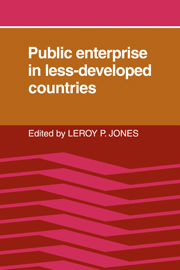Book contents
- Frontmatter
- Contents
- List of contributors
- List of figures and tables
- Preface
- 1 Introduction
- Part I Why public enterprise?
- Part II Principal-agent relationships: Who should control public enterprises?
- 4 State-owned enterprise: an agent without a principal
- 5 Social accountability of public enterprises: law and community controls in the new development strategies
- Part III How are decisions made in practice?
- Part IV How do public enterprises behave in international markets?
- Part V How does risk alter public-enterprise decisions?
- Part VI How are incentive structures to be designed?
- Part VII How does public enterprise compare with other intervention mechanisms in overcoming particular problems?
4 - State-owned enterprise: an agent without a principal
Published online by Cambridge University Press: 04 August 2010
- Frontmatter
- Contents
- List of contributors
- List of figures and tables
- Preface
- 1 Introduction
- Part I Why public enterprise?
- Part II Principal-agent relationships: Who should control public enterprises?
- 4 State-owned enterprise: an agent without a principal
- 5 Social accountability of public enterprises: law and community controls in the new development strategies
- Part III How are decisions made in practice?
- Part IV How do public enterprises behave in international markets?
- Part V How does risk alter public-enterprise decisions?
- Part VI How are incentive structures to be designed?
- Part VII How does public enterprise compare with other intervention mechanisms in overcoming particular problems?
Summary
State-owned enterprises (SOEs) comprise a large and rapidly growing sector of the economy in the majority of countries in the world today. They have been established to achieve a broad array of public policy purposes in very diverse political and economic systems. Typically, they account for half or more of total government investment, and in 1978 the international borrowings alone of public-sector enterprises amounted to more than $30 billion, equal to the total foreign borrowings by central governments in the past year. As international exporters, importers, and investors, SOEs are helping to shape the emerging structure of trade and payments relations in the 1980s. Their presence outside their traditional domain of public utilities is being felt especially in natural-resource-based and modern high-technology industries with high barriers to entry, in which private multinational firms have heretofore taken the lead. They are moving into a dominating position also in senescent industries such as textiles, shipbuilding, and steel, where the government moved in to save present firms from going under.
Yet despite the proliferation of SOEs since World War II, we actually know very little about the way they are managed. One reason for this lack of knowledge may be the tendency of economic theory to assume a perfect-market economy, in which firms passively transfer inputs procured in a perfect market into output sold in similar markets. Until recently, little attention has been paid to the problems and cost involved in managing an enterprise. By the same token, early socialist theoreticians saw the nationalization of production facilities as a way to achieve some equity and reduce “exploitation.”
- Type
- Chapter
- Information
- Public Enterprise in Less Developed Countries , pp. 67 - 76Publisher: Cambridge University PressPrint publication year: 1982
- 27
- Cited by



